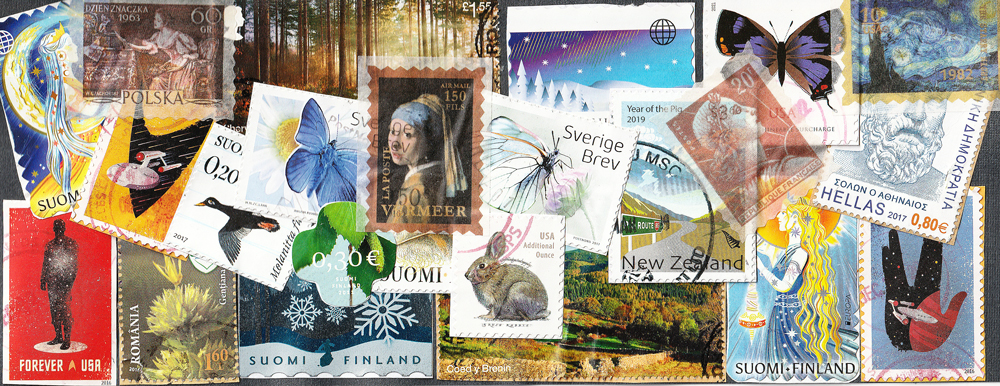Hachi – Japanese cymbals used in Buddhist ceremonies.
Hackbräde – Swedish hammered dulcimer.
Haegum – Korean two-string spiked fiddle. The haegum appears in four sizes, just like in the western fiddle family. The three smaller sizes are called so haegum, chung haegum and tae haegum. The largest version is called cho haegum.
Häjedalspipa – Swedish wooden flute.
Halam – Senegalese plucked lute. Also known as kontingo, xalam, ngoni and koni.
Hammered Dulcimer – a large zither with many strings in pairs, stretched over long bridges. It is played with small wooden or cane hammers. Played in the British Isles and North America.
Hardanger fiddle – Small Norwegian fiddle with four sympathetic running under the fingerboard. It is narrower, shorter-necked and more arched than the ordinary violin. The Hardanger fiddle is found in the western and central part of Norway. The Hardanger fiddle dates back to around 1700. The performer plays on two strings most of the time, creating a typical bourdon style. Also known as hardingfele and hardingfela.
The Hardanger fiddle is considered Norway’s national instrument. Its name derives from the fact that the first known fiddles of this type were crafted in Hardanger. The modern version of this instrument is slightly smaller than an ordinary fiddle (violin), is richly ornamented with (floral decoration) pen drawings and mother-of-pearl inlays. The oldest Hardanger fiddle still in existence that is registered is the Jåstad fiddle from 1651. (source: Folknett Norway)
Härjedalspipa – Wooden whistle from northwest Sweden.

Harmonica – a European free reed instrument formed by a block of 10 or more double sided reeds, mouth blown. The harmonica is also called mouth harp or simply harp in the United States, especially in the blues music field.

Harmonium – small, portable, bellow-blown reed organ used in India, Pakistan and Western countries. In Indian and Pakistani music, the player usually sits on the ground, with one hand fingering the keyboard and the other pumping bellows.

Harp – a plucked string instrument with strings stretched across a triangular frame. The harp originated in Mesopotamia and Egypt and spread to many other countries. It is widely used in classical and Celtic music. Variations include the double harp, with two rows of strings, and the Welsh triple harp.
Harpe – Norwegian harp. In various sources, some in written form and some as pictorial material, there is evidence that harps have been played in Norway since the Middle Ages. In Norwegian museums, nine harps have been preserved, seven of which are from Østerdalen. The harp is a plucked instrument, and is similar in form to the harp that is used in modern symphony orchestras, although quite a bit smaller. The Norwegian harp tradition is believed to have more or less died out by around the middle of the 1800s. When Tone Hulbækmo from Tolga in Østerdalen wanted to start playing the harp in the 1970s, she had an expert in medieval instrument-building from Oslo, Sverre Jensen, craft a copy for her of an old harp from northern Østerdalen, dated 1681. Today, the harp has returned to use in several places throughout the country. (source: Folknett Norway)
Harpsichord – double keyboard instrument plucked by quills or leather points. It was popular in Europe from the Renaissance to the early 19th century.
Hasapi – two-stringed mandolin from Sumatra (Indonesia).
Hayashi-bue – Bamboo transverse flute. Japan.
Highland pipes – Scottish bagpipes that are played standing, usually in pipe bands. The chanter has eight holes. There are two tenor drones, tuned an octave below the chanter and a bass drone a further octave down.

Hejjuj – Arabic word for Gnawan lute. Also known as sintir, sentir and guimbri.
Hira-daiko – flat drum. General term for a drum wider than it is deep.
Hne – Burmese flute.
Hojeok – a loud traditional double-reed oboe used in traditional Korean music and marching bands. Also known as taepyeongso, hojok, nallari and saenap.
Horagai – A large shell used as trumpet-type instrument. the horagai is not a conch shell, but either the pacific triton or the Shank shell.
Hosho – shaker. Zimbabwe
Hsiao – Chinese vertical flute made of bamboo.
Hu – Chinese bowed lute.
Huada – Chilean maracas.
Huapanguera – A 9 string Mexican guitar from the La Huasteca region of Mexico. It is used to play the son huapango song and dance. Also known as guitarra quinta huapanguera or guitarra huapanguera
Hu-ch’in – one of most widely used Chinese bowed lutes.
Hulusi – a double-reed with a gourd and two drone bamboo pipes with an interval of a major third. China.
Huluxiao – a gourd flute similar to the Hulusi. China.
Hummel – Dutch/Flemish instrument of the dulcimer family.
Huntsi – Siberian Inuit hand drum. it is beaten upon the skin itself, creating a deep resonant sound.
Huqin – Chinese fiddle. The huqin was introduced into China around 140 B. C., and has been one of the prevailing Chinese string instruments since that time. The erhu, ching-hu, gao-hu, and ban-hu are well-known members of the huqin family.
Hurdy Gurdy – a European string instrument in which a wheel turned by a hand crank vibrates the strings. The pitches are varied by a set of keys. Also known as zanfona, vielle, zanfoña.
Hyang-p’iri – Korean shawm. Cylindrical in form, it has seven finger holes.
Hyooshigi – Wooden blocks used as clappers, struck at the tips.

